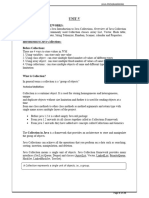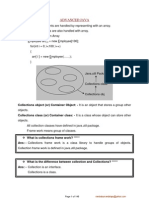0 ratings0% found this document useful (0 votes)
95 viewsJava Vector: Vector Is Like The Dynamic Array Which Can Grow or Shrink Its Size. Unlike Array, We
Vector implements a dynamic array that can grow or shrink as needed. It is found in the java.util package and implements the List interface. Vectors are similar to ArrayList but are synchronized, contain legacy methods, and maintain insertion order. They are recommended for thread-safe implementations, otherwise an ArrayList may perform better.
Uploaded by
aadi1988Copyright
© © All Rights Reserved
We take content rights seriously. If you suspect this is your content, claim it here.
Available Formats
Download as DOCX, PDF, TXT or read online on Scribd
0 ratings0% found this document useful (0 votes)
95 viewsJava Vector: Vector Is Like The Dynamic Array Which Can Grow or Shrink Its Size. Unlike Array, We
Vector implements a dynamic array that can grow or shrink as needed. It is found in the java.util package and implements the List interface. Vectors are similar to ArrayList but are synchronized, contain legacy methods, and maintain insertion order. They are recommended for thread-safe implementations, otherwise an ArrayList may perform better.
Uploaded by
aadi1988Copyright
© © All Rights Reserved
We take content rights seriously. If you suspect this is your content, claim it here.
Available Formats
Download as DOCX, PDF, TXT or read online on Scribd
You are on page 1/ 2
Java Vector
Vector is like the dynamic array which can grow or shrink its size. Unlike array, we
can store n-number of elements in it as there is no size limit. It is a part of Java
Collection framework since Java 1.2. It is found in the java.util package and
implements the List interface, so we can use all the methods of List interface here.
The Vector class implements a growable array of objects. Vectors basically
fall in legacy classes but now it is fully compatible with collections. It is found
in the java.util package and implements the List interface, so we can use all
the methods of List interface here.
Vector implements a dynamic array that means it can grow or shrink as
required. Like an array, it contains components that can be accessed
using an integer index
They are very similar to ArrayList but Vector is synchronized and has
some legacy method that the collection framework does not contain.
It also maintains an insertion order like an ArrayList but it is rarely used
in a non-thread environment as it is synchronized and due to which it
gives a poor performance in adding, searching, delete and update of its
elements.
The Iterators returned by the Vector class are fail-fast. In the case of
concurrent modification, it fails and throws
the ConcurrentModificationException.
It is recommended to use the Vector class in the thread-safe implementation only.
If you don't need to use the thread-safe implementation, you should use the
ArrayList, the ArrayList will perform better in such case.
The Iterators returned by the Vector class are fail-fast. In case of concurrent
modification, it fails and throws the ConcurrentModificationException.
It is similar to the ArrayList, but with two differences-
o Vector is synchronized.
o Java Vector contains many legacy methods that are not the part of a
collections framework.
Java Vector Example
import java.util.*;
class VectorExample {
public static void main(String args[]) {
//Create a vector
Vector<String> vec = new Vector<String>();
//Adding elements using add() method of List
vec.add("Tiger");
vec.add("Lion");
vec.add("Dog");
vec.add("Elephant");
//Adding elements using addElement() method of Vector
vec.addElement("Rat");
vec.addElement("Cat");
vec.addElement("Deer");
System.out.println("Elements are: "+vec);
}
}
You might also like
- I. RRC Connection Re-Establishment ProcedureNo ratings yetI. RRC Connection Re-Establishment Procedure4 pages
- Java - The Vector Class: Difference Between Array and VectorNo ratings yetJava - The Vector Class: Difference Between Array and Vector5 pages
- Object-Oriented Programming Lab 8: Collections of Data: Ton Duc Thang University Faculty of Information TechnologyNo ratings yetObject-Oriented Programming Lab 8: Collections of Data: Ton Duc Thang University Faculty of Information Technology10 pages
- 2003 Prentice Hall, Inc. All Rights ReservedNo ratings yet2003 Prentice Hall, Inc. All Rights Reserved56 pages
- Array:: Import Java - Util. Public Class Array (No ratings yetArray:: Import Java - Util. Public Class Array (11 pages
- 1-Classification and Real Time Application-18!12!2024No ratings yet1-Classification and Real Time Application-18!12!202416 pages
- Q2: Is Null Is A Keyword ? Ans: Q: What Is Difference Between Arraylist and Vector Ans Vector Are Synchronized When Arraylist Are Not SychronizedNo ratings yetQ2: Is Null Is A Keyword ? Ans: Q: What Is Difference Between Arraylist and Vector Ans Vector Are Synchronized When Arraylist Are Not Sychronized1 page
- Package and Some Classes: Declaration of Package Usage of Package Package of Java LanguageNo ratings yetPackage and Some Classes: Declaration of Package Usage of Package Package of Java Language34 pages
- Java Package Mastery: 100 Knock Series - Master Java in One Hour, 2024 EditionFrom EverandJava Package Mastery: 100 Knock Series - Master Java in One Hour, 2024 EditionNo ratings yet
- Advanced JAVA Interview Questions You'll Most Likely Be AskedFrom EverandAdvanced JAVA Interview Questions You'll Most Likely Be AskedNo ratings yet
- Computer Fundamental & Office AutomationNo ratings yetComputer Fundamental & Office Automation17 pages
- Assignment Specification OO ADI Module 7CS091 2021 AutmnNo ratings yetAssignment Specification OO ADI Module 7CS091 2021 Autmn10 pages
- Java Programming and Dynamic Webpage Design80% (10)Java Programming and Dynamic Webpage Design3 pages
- Base & Derived Classes:: C++ InheritanceNo ratings yetBase & Derived Classes:: C++ Inheritance5 pages
- Computer Fundamental & Office AutomationNo ratings yetComputer Fundamental & Office Automation9 pages
- E - Commerce Activities The e Commerce Activities Some Common Applications Related To Electronic Commerce AreNo ratings yetE - Commerce Activities The e Commerce Activities Some Common Applications Related To Electronic Commerce Are3 pages
- Virtual Memory in Operating System Virtual Memory in Operating SystemNo ratings yetVirtual Memory in Operating System Virtual Memory in Operating System2 pages
- Q9. How Can We Change The Default Boot Partition From Bios?: Computer Hardware and Networking TestNo ratings yetQ9. How Can We Change The Default Boot Partition From Bios?: Computer Hardware and Networking Test1 page
- Download Exploring Aging Masculinities: The Body, Sexuality and Social Lives 1st Edition David Jackson (Auth.) ebook All Chapters PDF100% (2)Download Exploring Aging Masculinities: The Body, Sexuality and Social Lives 1st Edition David Jackson (Auth.) ebook All Chapters PDF65 pages
- PDF Exercises Say and Tell As Introductory Verbs CompressNo ratings yetPDF Exercises Say and Tell As Introductory Verbs Compress8 pages
- PermitRequirements StationaryStorageBatterySystems2016 PDFNo ratings yetPermitRequirements StationaryStorageBatterySystems2016 PDF2 pages
- Exp. 5 To Estimate The Materials of Rectangular Watercourse From Given Profile SurveyNo ratings yetExp. 5 To Estimate The Materials of Rectangular Watercourse From Given Profile Survey4 pages
- Financial Statement (Balance Sheet, Trading Account, Profit and Loss Account), Ratio AnalysisNo ratings yetFinancial Statement (Balance Sheet, Trading Account, Profit and Loss Account), Ratio Analysis52 pages
- 2-D Analysis of Circular Tunnel Against Earthquake LoadingNo ratings yet2-D Analysis of Circular Tunnel Against Earthquake Loading7 pages




















































































































